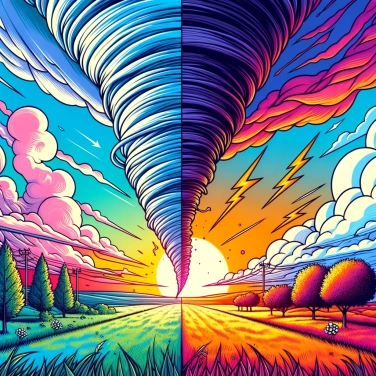Some regions of the world, such as the Great Plains in the United States, are more prone to tornadoes due to the collision of hot and humid air masses from the Gulf of Mexico with cold air from the north, creating meteorological conditions favorable for the formation of these violent phenomena.

Tornadoes often occur in regions where very different air currents meet. It all starts when warm, humid currents from the south violently collide with cold, dry air descending from the north. This tumultuous encounter creates explosive atmospheric instability, ideal for tornado formation. In North America, for example, the Jet Stream, this fast-moving high-altitude air current, plays a key role: it accentuates temperature differences and pushes these air masses to confront each other violently. The result is powerful winds that spin rapidly and regularly generate spectacular tornadoes.
Mountain ranges often play a role as a natural obstacle directly influencing local and regional weather conditions. Essentially, when a mass of moist air encounters a mountain range, it is forced to rise rapidly, cools at altitude, which can create sudden and marked variations in temperature and humidity. This dynamic propels an unstable mix of warm and cold air, sometimes fueling the formation of supercell thunderstorms, which can lead to tornadoes. However, be careful, mountains do not always mean tornadoes: depending on their location or orientation, some mountain ranges can, on the contrary, disrupt the dynamics of air currents, limiting their formation. It can be said that mountains can either amplify the conditions conducive to tornadoes or calm the situation depending on their precise geography.
Temperate regions are particularly affected by tornadoes, as they often experience the brutal encounter of cold, dry air masses coming from the north and warm, humid air masses rising from the south. When these two very different types of air confront each other, it creates significant instabilities. As a result, the warm air rises quickly while the cold air descends sharply: a perfect cocktail for generating severe thunderstorms and, potentially, tornadoes. These conditions often occur in spring or early summer, times when thermal differences between air masses are generally the most pronounced.
Large bodies of water, such as oceans or large lakes, act as giant reservoirs of moisture. Water evaporates, forming warm, humid air masses, and when they encounter cooler currents, it creates instability conducive to violent storms. When these unstable air masses move inland, the sharp contrast with drier conditions further increases the risk of tornado formation. In the United States, for example, the warm, humid air from the Gulf of Mexico is one of the key reasons why the region nicknamed Tornado Alley experiences so many tornadoes each year.
Tornadoes generally rotate counterclockwise in the Northern Hemisphere, but there are rare instances where they can rotate in the opposite direction.
On average, the United States experiences about 1,200 tornadoes each year, while Europe sees around 300 annual tornadoes, often of lower intensity.
The highest wind speed ever recorded in a tornado exceeds 480 km/h! Such extreme speeds can cause significant damage in just a few seconds.
Tornado Alley in the United States is the most active tornado region in the world, due to the frequent meeting of cold air from Canada and warm, humid air from the Gulf of Mexico.
When a tornado warning is issued or a tornado is approaching, it is essential to immediately seek shelter in a safe place: a basement, cellar, or an interior room without windows on the ground floor, such as a bathroom or a sturdy closet. Ideally, it is recommended to wear a helmet or protect your head with your arms and a thick blanket to avoid injuries from debris.
The United States is particularly conducive to tornadoes due to its unique geographical configuration. In the Central Great Plains ('Tornado Alley'), warm, moist air from the Gulf of Mexico frequently meets dry, cool air descending from the Rocky Mountains and Canada. This interaction creates the atmospheric instability necessary for the frequent development of tornadoes.
Signs indicating the possible approach of a tornado include: a sudden change in the weather, very dark clouds with an unusual greenish color, a sound resembling a rumble or the passage of a train, the presence of a funnel-shaped cloud descending toward the ground, and a sudden drop in temperatures or an increase in wind.
A tornado is a highly localized swirling column of air that typically forms under a thunderstorm. It impacts a small area for a short duration but with violent winds. A hurricane or cyclone is a vast tropical system that forms over warm oceans, covering a large area, lasting for days or weeks, with sustained winds that are generally less violent than those of a tornado.
Yes, even though tornadoes can occur throughout the year, the majority of them happen in the spring and early summer in the northern hemisphere (from April to July). It is during this period that the contrasts between warm air at the surface and cold air aloft promote their formation.
Tornadoes can indeed occur in any region, whether urban or rural. The more frequent representation of tornadoes affecting rural areas is simply due to the fact that these areas cover a larger surface; thus, the chances of a tornado hitting a dense city are statistically lower but entirely possible.

No one has answered this quiz yet, be the first!' :-)
Question 1/6